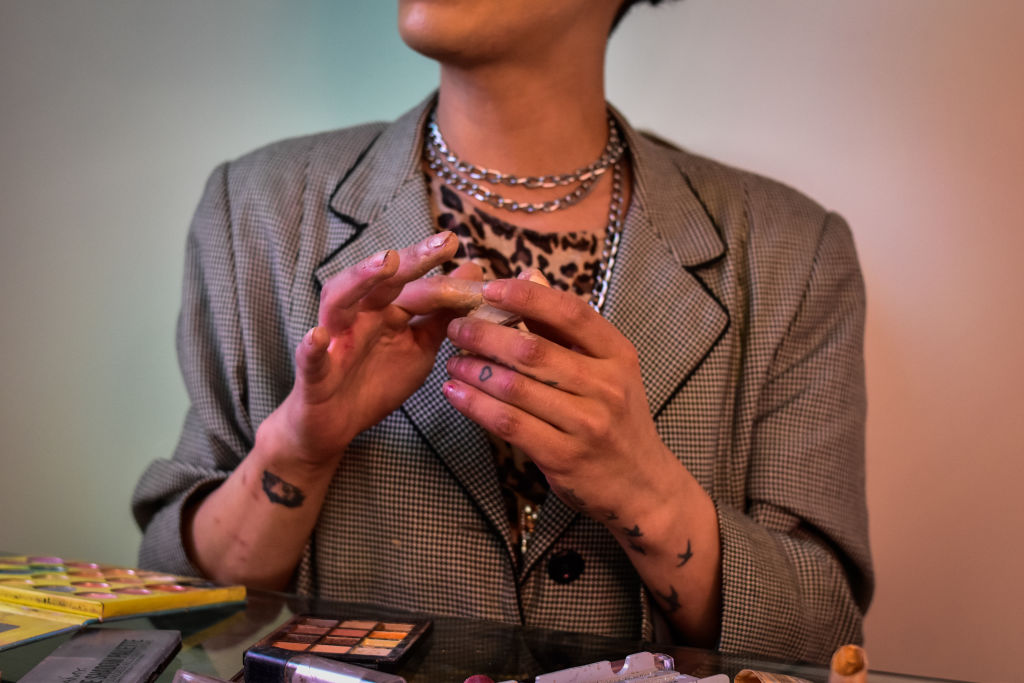We need to reframe how we think about the cost of cosmetics through the lens of gender-affirming care and practice.

For Alice, a young transgender woman, navigating out of homelessness, a $40 bottle of foundation is lifesaving. She regularly purchases it, despite the steep price, because it’s the only product that properly covers the shadow of her facial hair. Doing so ensures that she is not identified and targeted as trans in public—something that would be impossible to accomplish with a cheap foundation.
I remember the first makeup I ever bought: It was a blue eyeshadow palette and a $0.99 Wet-n-Wild tube of cotton candy pink lipstick. Nine years later, my boss gently suggested to me that a woman my age should have a better quality of makeup and took me to a store to buy MAC concealer and powder. I slightly balked at the cost, but chalked it up to what was expected of me to excel professionally, and ignored the expense on my credit card. It would take another 14 years and a coveted job promotion before I felt financially secure enough to splurge on a $44 tube of Givenchy lipstick called “forbidden red” at Sephora.
From physical safety to job security, how your present yourself to the world is critical. To transgender and other LGBTQ+ youth—in particular those that are unhoused, at risk or street involved—beauty products like makeup or haircare are neither optional nor frivolous expenses. These particular costs are both a lifeline and a burden for trans youth who are attempting to navigate the many systems in which they must operate, including, for some, systems of homelessness.
There are significant systemic challenges that homeless LGBTQ+ youth encounter in trying to navigate into adulthood. There are the barriers to stable employment and housing, the relentless onslaught of harassment and discrimination, and the prohibitive costs that hinder access to gender-affirming care.
This is another important way to think of cosmetics, razors and other like items: harm reduction.
Whether it’s hormone therapy, hair removal, gender confirmation surgery or living ones’ gender identity through clothing and makeup, these choices are based on a critical need. Hormone replacement therapy averages between $40 and 400 a month, and gender-affirming surgery can be anywhere between $8,000 to $25,000, to say nothing about the regular and consistent costs of hair removal ($200-400), wardrobe and cosmetics. Americans spend $1,754 a year on beauty products, according to one study; however, that number doesn’t reflect the particular costs of cosmetics for the trans community, nor is there reliable information on the inflated costs of beauty products due to the pink tax, which disproportionately impact trans women.
These costs, on top of concerns about ensuring enough money for rent, food and utilities, manifest in daily and often difficult decisions.
My client Amelia, a young transgender woman, spent years trying to create financial stability in her life. She successfully navigated out of a homeless shelter and into an apartment with the help of a federal subsidy, and landed a steady job at a department store that no longer required her to worry that she would be fired if she missed a day of work. And yet, first and foremost, she often found herself making decisions such as, “Am I going to be able to eat, or buy razors?” Her daily financial choices are born out of a need to ensure that she can provide her own gender-affirming care, a choice markedly unlike those of her cisgender peers.
This is another important way to think of cosmetics, razors and other like items: harm reduction. Trans women experience severe risk of violence merely for existing in the world, and these critical items are key to their safety, as Alice’s need also highlighted.
To transgender and other LGBTQ+ youth—in particular those that are unhoused, at risk or street involved—beauty products like makeup or haircare are neither optional nor frivolous expenses.
The way our society tends to frame commodities like cosmetics as frivolous, almost luxury purchases, misses that they are an essential, critical matter for many young people—just as important as other necessities—and that they save people’s lives.
In New York City, some community-based organizations that work with homeless, at-risk and street-involved queer and trans youth provide access to financial coaches whose aim is to empower young people by giving them a sense of belonging and support while navigating their financial decisions.
For homeless young people, every single cent they have matters. The additional expenses of gender-affirming practice and care—razors, cosmetics, clothing—are life necessities, and a matter of basic safety.
When we talk about financial literacy, we need to understand the different considerations that unhoused queer and trans youth must make when balancing a budget—from the need for MAC cosmetics, to hormone replacement therapy, to top surgery.
Alice and Amelia’s razors, clothing and cosmetics can’t be dismissed or ridiculed. These costs are not the reason that they, nor so many other young LGBTQ+ youth, struggle with financial insecurity. In fact, these pieces of gender-affirming care help them build the stable, authentic lives they deserve.
Up next:
U.S. democracy is at a dangerous inflection point—from the demise of abortion rights, to a lack of pay equity and parental leave, to skyrocketing maternal mortality, and attacks on trans health. Left unchecked, these crises will lead to wider gaps in political participation and representation. For 50 years, Ms. has been forging feminist journalism—reporting, rebelling and truth-telling from the front-lines, championing the Equal Rights Amendment, and centering the stories of those most impacted. With all that’s at stake for equality, we are redoubling our commitment for the next 50 years. In turn, we need your help, Support Ms. today with a donation—any amount that is meaningful to you. For as little as $5 each month, you’ll receive the print magazine along with our e-newsletters, action alerts, and invitations to Ms. Studios events and podcasts. We are grateful for your loyalty and ferocity.





